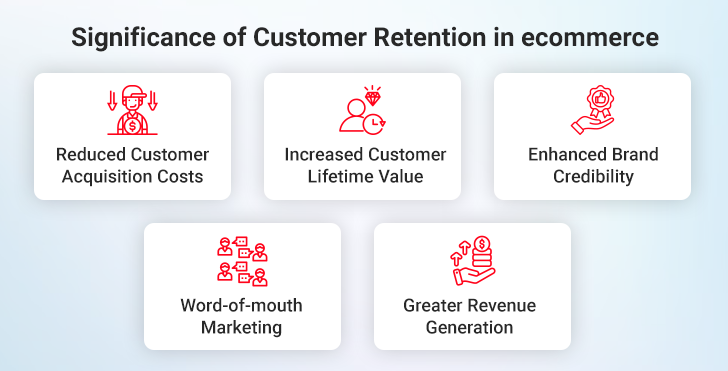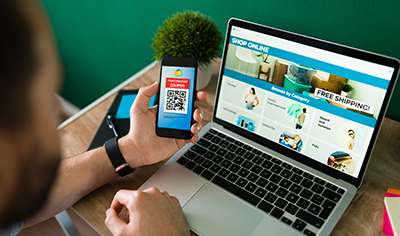When you ask any ecommerce c-suite stakeholder about important marketing metrics to track, they would mention gross margin, average order value, and conversion rate. They are less likely to mention the customer retention rate, which is odd but an equally important metric.
Shoppers are spoilt with choices as there are endless options for almost everything. Additionally, the surge of new online businesses creates a saturated marketplace. Getting a new customer onboard amidst such circumstances becomes even more difficult, which is why customer retention is important. So, the competitive advantage lies not only in acquiring new customers, but also in transforming one-time shoppers into repeat purchasers.
The Customer Acquisition v/s Retention Conundrum
Acquiring new customers is undoubtedly essential for business growth. But, nurturing and retaining the ones you already have is equally – if not more – important. Not to forget, existing customers buy more, spend more, and act as free-of-cost brand advocates by generating referrals. Besides, retaining the old customers is much easier and far more cost-friendly than winning the new ones.
Every dollar invested in acquiring a new customer can contribute to ten or more repeat sales, given the same dollar was invested in strategies aimed at customer retention. The small act of winning back a customer has a huge impact on the brand as a mere 5% increase in customer retention can propel company revenue by a staggering 25-95%.
While accounting for only 21%, repeat customers generate 44% of revenue and 46% of orders. Thus, ecommerce businesses can achieve sustainable growth by converting one-time shoppers into repeat purchasers. Customer retention is a fail-proof strategy that enables stakeholders to reap more profits, especially when the chances of selling to an existing customer are far greater than selling to a new prospect.
Create your Ecommerce Store with Minimal Efforts
Retention Strategies to Convert First-time Customers to Loyal Brand Advocates
Customer retention is a sure-shot way to achieve lasting success for every online store owner. Implementing the below-listed strategies can help ensure that your customers keep coming back to you for more:
1. Curate Hassle-free Navigation Experiences
Even in Shopify stores, customers scroll through different sections and categories, just as they stroll through a brick-and-mortar store to find something. But in the online model, customers can directly search for the product/service they are looking for and get it within a few clicks. If it takes longer than usual to load what they are looking for, customers might abandon the cart. So, it is important to keep a check on the usability and convenience of the website.
You can get help from professional Shopify website developers to craft a user-friendly experience with intuitive design, clear product information, and a smooth checkout process. Additionally, these experts optimize your store for mobile devices, where a significant portion of online shopping occurs.
2. Encourage Customers to Create Accounts
Encouraging customers to create accounts on your Shopify stores is the simplest and most effective way to retain customers. Repurchasing gets easier with accounts as customers can find all the details from previous orders instantly along with pre-filled shipping information. To make them feel valued, you can also consider offering lucrative deals and birthday promotions to your customers.
On the other hand, creating accounts can be a major commitment for new customers. Hence, many people choose to ‘checkout as a guest’ if the option is available. So, how do you not hinder conversions for first-time customers and encourage accounts? The hack is to provide an option for account creation after the first order has been placed. Professional Shopify developers can help you build visually appealing and informative online storefronts that resonate with customers and encourage them to create accounts.
3. Incentivize Customers Via Loyalty Programs
Loyalty programs are a tried and tested way to boost retention rates. This is a win-win for both parties as customers get more value each time they shop while Shopify store owners benefit from repeat businesses. Creating such programs is as easy as rewarding customers for their second purchase, or after shopping for a particular amount.
Other than this, you can also reward loyal customers with early access to new products, exclusive discounts, or free shipping to encourage continued patronage. You can also hire a Shopify expert to automate loyalty programs and incentivize your customers for multiple actions that they take.
4. Use Email Marketing to Build Lasting Relationships
Email marketing is the most powerful retention tool in your kit, letting you build connections before and after the purchase. In fact, email is a primary customer acquisition channel for around 81% of SMBs. Acknowledging the customers with emails like ‘Thank you for shopping with us’ after the purchase makes them feel valued and makes your brand more approachable. Most importantly, ensure your emails are mobile-friendly and visually attractive with clear CTAs to encourage recipients to act.
To keep the conversations going, you can send targeted emails with personalized product recommendations, post-purchase follow-ups, exclusive or limited-period offers, and more. In context to the post-sale marketing communications, consider sending friendly reminders of why customers bought a product/service from your store initially. Remember, getting the customers back to shop from you lies in your ability to demonstrate why an additional purchase is worth their time and money.
5. Provide Prompt and Helpful Customer Services
Prompt and friendly customer support services set the gold standards and make all the difference in retaining customers. Plus, a satisfied customer is sure to get back to your shop for repeat purchases. So, make sure you provide a quick and helpful response to their inquiries and concerns. Shopify website designers can incorporate elements like live chat and self-service options including a knowledge base or FAQs. This lets customers find answers to their queries quickly, without your support team’s direct assistance.
6. Actively Listen to Customers by Gathering Feedback
Actively listening to what your customers have to say about the product bought/service availed can help you identify your USPs and uncover areas that need improvement. You can gather their feedback through reviews, surveys, social media polls, etc., which can then be used to personalize offerings and improve overall experiences for customers. This also demonstrates that a customer’s feedback is valued and that the brand is dedicated to providing the best possible experience.
7. Create a Seamless ‘Return’ Process
The ‘return’ process has a significant role in making your customer retention a ‘hit’ or a ‘failure.’ A great return experience promotes loyal patronage as 92% of the consumers revisit brands to buy again. You can perfect your return process by creating transparent policies that explain what qualifies for return and what doesn’t. You can also build a self-help customer service portal that lets people request exchanges, track their returns, generate labels, and so on.
8. Lock in Customers Through Subscription Services
Subscription services lock customers into purchasing the products/availing the services for a set period. This not only keeps the customers engaged, but also generates recurring revenue for businesses. Plus, a subscription helps you be assured that the customer is enjoying your product/service and ‘wants’ to stay involved. The best part is you need not make subscription service your entire business model like Netflix. Instead, you can consider offering a standalone subscription box like Amazon Prime or recurring deliveries for essential products—fostering a sense of exclusivity and providing convenience.
Putting everything in a nutshell, customer retention is equally important as customer acquisition. While the latter plays a crucial role in driving business growth, the real value lies in fostering long-term relationships via effective customer retention strategies.
Closing Thoughts
A satisfied customer is your best marketing asset. Investing in their experiences is investing in your brand, which surely offers an incremental ROI in the long run. So, prioritize creating a seamless user experience by crafting a high-quality Shopify website. For this, you can hire a Shopify developer who not only helps in optimizing your digital storefront’s functionality, but also ensures a positive customer journey from the first click to checkout.







